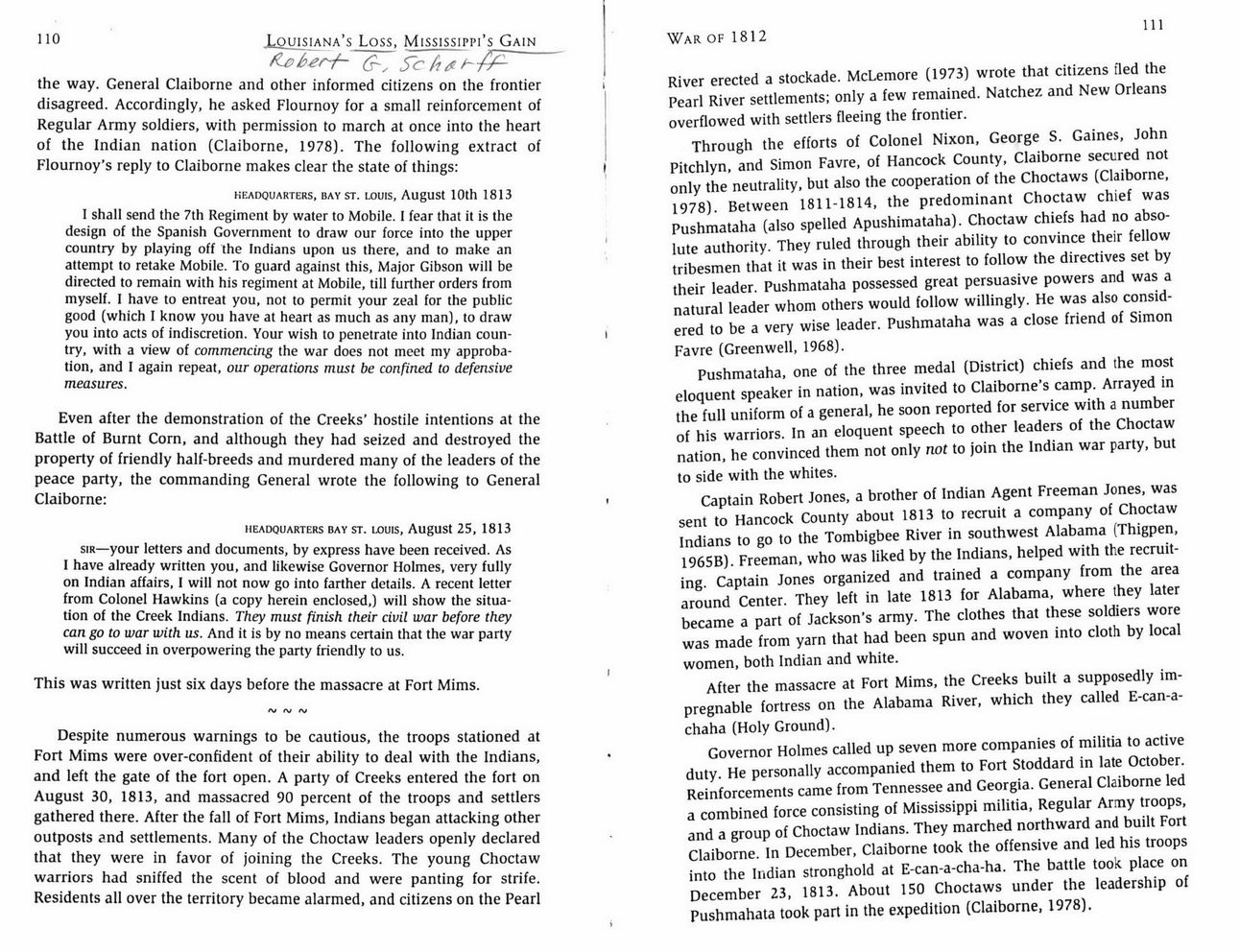This text was obtained via automated optical character recognition.
It has not been edited and may therefore contain several errors.
110 Louisiana?s Loss, Mississippi's Gain Sc ftfi the way. General Claiborne and other informed citizens on the frontier disagreed. Accordingly, he asked Flournoy for a small reinforcement of Regular Army soldiers, with permission to march at once into the heart of the Indian nation (Claiborne, 1978). The following extract of Flournoy?s reply to Claiborne makes clear the state of things: HEADQUARTERS, BAY ST. LOUIS, AUgUSt 10th 1813 I shall send the 7th Regiment by water to Mobile. 1 fear that it is the design of the Spanish Government to draw our force into the upper country by playing off the Indians upon us there, and to make an attempt to retake Mobile. To guard against this, Major Gibson will be directed to remain with his regiment at Mobile, till further orders from myself. I have to entreat you, not to permit your zeal for the public good (which I know you have at heart as much as any man), to draw you into acts of indiscretion. Your wish to penetrate into Indian country, with a view of commencing the war does not meet my approbation, and I again repeat, our operations must be confined to defensive measures. Even after the demonstration of the Creeks? hostile intentions at the Battle of Burnt Corn, and although they had seized and destroyed the property of friendly half-breeds and murdered many of the leaders of the peace party, the commanding General wrote the following to General Claiborne: HEADQUARTERS BAY ST. LOUIS, August 25, 1813 sir?your letters and documents, by express have been received. As I have already written you, and likewise Governor Holmes, very fully on Indian affairs, 1 will not now go into farther details. A recent letter from Colonel Hawkins (a copy herein enclosed,) will show the situation of the Creek Indians. They must finish their civil war before they can go to war with us. And it is by no means certain that the war party will succeed in overpowering the party friendly to us. This was written just six days before the massacre at Fort Mims. A/ (V IN/ Despite numerous warnings to be cautious, the troops stationed at Fort Mims were over-confident of their ability to deal with the Indians, and left the gate of the fort open. A party of Creeks entered the fort on August 30, 1813, and massacred 90 percent of the troops and settlers gathered there. After the fall of Fort Mims, Indians began attacking other outposts and settlements. Many of the Choctaw leaders openly declared that they were in favor of joining the Creeks. The young Choctaw warriors had sniffed the scent of blood and were panting for strife. Residents all over the territory became alarmed, and citizens on the Pearl War of 1812 111 River erected a stockade. McLemore (1973) wrote that citizens fled the Pearl River settlements; only a few remained. Natchez and New Orleans overflowed with settlers fleeing the frontier. Through the efforts of Colonel Nixon, George S. Gaines, John Pitchlyn, and Simon Favre, of Hancock County, Claiborne secured not only the neutrality, but also the cooperation of the Choctaws (Claiborne, 1978). Between 1811-1814, the predominant Choctaw chief was Pushmataha (also spelled Apushimataha). Choctaw chiefs had no absolute authority. They ruled through their ability to convince their fellow tribesmen that it was in their best interest to follow the directives set by their leader. Pushmataha possessed great persuasive powers and was a natural leader whom others would follow willingly. He was also considered to be a very wise leader. Pushmataha was a close friend of Simon Favre (Greenwell, 1968). Pushmataha, one of the three medal (District) chiefs and the most eloquent speaker in nation, was invited to Claiborne?s camp. Arrayed in the full uniform of a general, he soon reported for service with a number of his warriors. In an eloquent speech to other leaders of the Choctaw nation, he convinced them not only not to join the Indian war party, but to side with the whites. Captain Robert Jones, a brother of Indian Agent Freeman Jones, was sent to Hancock County about 1813 to recruit a company of Choctaw Indians to go to the Tombigbee River in southwest Alabama (Thigpen, 1965B). Freeman, who was liked by the Indians, helped with the recruiting. Captain Jones organized and trained a company from the area around Center. They left in late 1813 for Alabama, where they later became a part of Jackson?s army. The clothes that these soldiers wore was made from yarn that had been spun and woven into cloth by local women, both Indian and white. After the massacre at Fort Mims, the Creeks built a supposedly impregnable fortress on the Alabama River, which they called E-can-a-chaha (Holy Ground). Governor Holmes called up seven more companies of militia to active duty. He personally accompanied them to Fort Stoddard in late October. Reinforcements came from Tennessee and Georgia. General Claiborne led a combined force consisting of Mississippi militia, Regular Army troops, and a group of Choctaw Indians. They marched northward and built Fort Claiborne. In December, Claiborne took the offensive and led his troops into the Indian stronghold at E-can-a-cha-ha. The battle took place on December 23, 1813. About ISO Choctaws under the leadership of Pushmahata took part in the expedition (Claiborne, 1978).

Nixon Louisiana's-Loss-Mississippi's-Gain-War-of-1812--part1